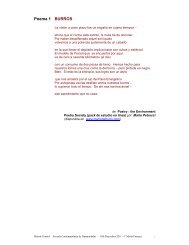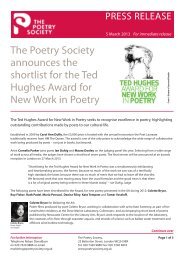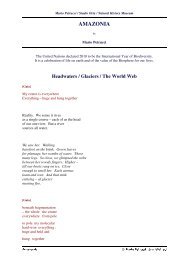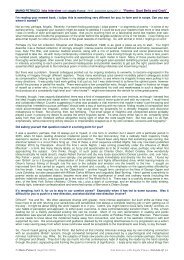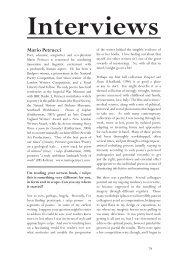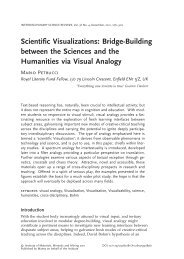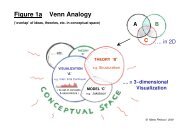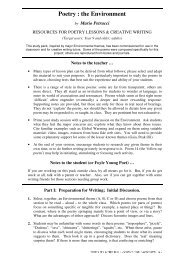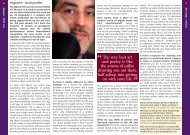poetry in performance: intertextuality, intra-textuality ... - Mario Petrucci
poetry in performance: intertextuality, intra-textuality ... - Mario Petrucci
poetry in performance: intertextuality, intra-textuality ... - Mario Petrucci
You also want an ePaper? Increase the reach of your titles
YUMPU automatically turns print PDFs into web optimized ePapers that Google loves.
VI. PUBLIC POEMS: PERFORMANCE POEMS WITHOUT THE PERFORMER ?<br />
I have already drawn attention to the fact that, <strong>in</strong> recent years, poems and poets have been deployed <strong>in</strong>creas<strong>in</strong>gly <strong>in</strong><br />
public spaces <strong>in</strong> the UK (eg, as part of Lottery-funded community activity). I have worked on several such projects,<br />
and there is much that can (and ought to) be said about them. I do not want, though, to <strong>in</strong>flate the role of Poeclectics<br />
<strong>in</strong> this to false levels; so I shall first raise some theoretical po<strong>in</strong>ts of a related but more general nature. Once this has<br />
been done, I will feel more comfortable about draw<strong>in</strong>g <strong>in</strong> issues of particular relevance to Poeclectics.<br />
A major po<strong>in</strong>t here is that whenever poems are sited off the page so as to draw the viewer <strong>in</strong>to some further act<br />
beyond read<strong>in</strong>g (or <strong>in</strong>to some other type of conceptual process) there is a sense <strong>in</strong> which the poem operates as a<br />
<strong>performance</strong> piece without a performer. This entails the orchestration of a special relationship between the text and<br />
its ‘situation’ (= “the properties and relations of objects and people <strong>in</strong> the vic<strong>in</strong>ity of the text, as perceived by the<br />
participants” [21]). Naturally, poems <strong>in</strong> books have ‘situations’ too; but an example of the k<strong>in</strong>d of <strong>in</strong>novative<br />
situational development I mean is provided by ‘Trench’, part of my Poetry Hunt at the Imperial War Museum. It<br />
<strong>in</strong>volves a telescopic sight, down which - <strong>in</strong>variably - children cannot resist look<strong>in</strong>g. When they do, they read a<br />
poem fixed on a distant pillar at about head height, on a flight of stairs heavily used by visitors.<br />
TRENCH<br />
Sniper, Sniper, <strong>in</strong> your tree -<br />
has your eye closed <strong>in</strong> on me?<br />
Did your sights hot-cross my head<br />
before you chose young Phil <strong>in</strong>stead?<br />
If looks could kill, would I be dead?<br />
Sniper, Sniper, the one you get<br />
doesn't hear your rifle crack.<br />
They're say<strong>in</strong>g here that you've the knack.<br />
They're tell<strong>in</strong>g me I've lost a bet -<br />
they say I'm dead. I just don't know it yet.<br />
‘Trench’ does more than br<strong>in</strong>g to the attention of visitors (Intertextually?) one narrative strand of the Museum’s<br />
archives (<strong>in</strong> this case, the grotesque camaraderie and practical jok<strong>in</strong>g sometimes engendered by war). Nor is it a<br />
gimmick. Rather, visitors’ reactions to this piece <strong>in</strong> its site-specific context suggest that the poem creates a k<strong>in</strong>d of<br />
para-textual space (termed ‘synaesthetic space’ [27]). Not only is a complex and multifaceted response elicited <strong>in</strong><br />
the reader through the careful construction and location of an apparently ‘l<strong>in</strong>ear’ text, but that text is also ‘activated’<br />
by readers <strong>in</strong>to new types of association. In effect, the poem’s situation acquires, as well as delivers, opportunities<br />
for the text to be ‘read’ multidimensionally (and beyond mere content), with text, reader and environment draw<strong>in</strong>g<br />
on one another for new and extended resonances (hence the ‘synaesthetic’ term). In ‘Trench’, the substance of the<br />
poem has been extended <strong>in</strong>to the optical system of the telescopic sight, a move designed to both frame and modify<br />
the way <strong>in</strong> which the text is read. This telescopic situation is heightened through certa<strong>in</strong> formal aspects of the poem,<br />
with the language conditioned by the new space. For <strong>in</strong>stance, the hard end-rhymes emphasise a sniper-like scann<strong>in</strong>g<br />
of the eye, while the familiar child-like naïveté of the open<strong>in</strong>g l<strong>in</strong>es (rem<strong>in</strong>iscent of ‘Tw<strong>in</strong>kle Tw<strong>in</strong>kle Little Star’)<br />
evokes vulnerability together with an ironic sense of the morbidly s<strong>in</strong>ister game the soldiers are play<strong>in</strong>g. These<br />
textual factors comb<strong>in</strong>e with the physical action of ‘sight<strong>in</strong>g’ the poem to generate a matrix for reception far more<br />
resonant than that of the page alone.<br />
I f<strong>in</strong>d Poeclectics a productive and natural mode to adopt for situational writ<strong>in</strong>g. The effects are most arrest<strong>in</strong>g, it<br />
seems, when the poem is connected <strong>in</strong>timately to Contexts (= “everyth<strong>in</strong>g around the text” [28]) such as physical<br />
environments hav<strong>in</strong>g a dist<strong>in</strong>ctive quality or character, or to local Intertexts (eg familiar folk narratives). The sit<strong>in</strong>g<br />
of ‘Missile’ on a Museum ceil<strong>in</strong>g, aligned with the pr<strong>in</strong>cipal axis of the Exocet missile suspended there, is a case of<br />
strong Contextual synergy. The Exocet’s difficult Context (visitors have to crane upwards to see it, and normally<br />
look for just a few moments) guided the poem’s composition towards a stark and immediate concrete message,<br />
forged <strong>in</strong> a highly resonant spatio-visual form. I would describe the poem as loosely Poeclectic: its Contextuallysensitive<br />
‘<strong>performance</strong>’ relies on a primitive characterisation that is accessible and role-specific, yet deeply<br />
suggestive.<br />
12



